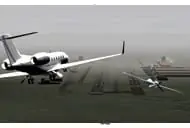Small unmanned aircraft systems (UAS) flying in the national airspace will soon be a reality with the passage of the Federal Aviation Administration’s Reauthorization and Modernization bill. At AUVSI Unmanned Systems North America 2012, Rockwell Collins is inviting attendees to get a three-dimensional, animated look at what the convergence of UAS and manned aircraft will look like. Join Rockwell Collins in Booth 1651 for a look into the future.
“Integrating UAS into the national airspace will require advanced technology in order to ensure that flight safety is maintained,” said Dave Schreck, director of UAS and Control Technologies for Rockwell Collins. “This video provides a glimpse into how we see this happening using our company’s advanced flight control, navigation and communication technology to enable the convergence of UAS with manned aircraft.”
Rockwell Collins will also be displaying a number of flight control, navigation, communication and simulation and training systems that will enable the safety of flight for UAS at its exhibit. Those technologies include:
• The Athena Family of Flight Controls – The Rockwell Collins Athena family of flight controls offer Inertial Navigation, Global Positioning, Air Data, Attitude, Heading and Reference System (INS/GPS/ADAHRS) and autopilot products, all integrated into a single package designed to operate in demanding temperature, shock and vibration environments. This compact package results in a plug-and-play avionics architecture, facilitating easy installation and maintenance and enabling a shorter time to market and success.
• Small Mission Computer – The GPC-3000 Small Mission Computer offers a variety of Rockwell Collins capabilities including advanced computing and memory capacity, tamper detection and data encryption, information assurance through multiple levels of security, and an open systems software architecture. The computational resources of GPC-3000 in a compact package enable a variety of payload and mission processing applications including digital video playback for real time review of surveillance data.
• MicroGRAM – The MicroGRAM reliably provides secure military GPS technology for very small, size constraint equipment. Much smaller and lighter than its predecessor, the Miniature PLGR Engine-SAASM (MPE-S), the MicroGRAM is slightly bigger than a large postage stamp, while still providing the valuable Selective Availability/Anti-Spoofing Module (SAASM) GPS technology. SAASM GPS encapsulates all GPS classified data and signal processing into one tamper-proof module, providing jamming and spoofing protection for U.S. and allied forces operating in hostile environments. The MicroGRAM is another example of Rockwell Collins’ strong legacy in providing innovative military GPS capabilities.
• ARC-210 Gen5 software defined radio for airborne military platforms – In April 2011, Rockwell Collins delivered its newest generation ARC-210 Gen5 radio, the first-to-market airborne radio that provides software-defined networking capabilities and cryptographic modernization features.
• TacNet Tactical Radio – The TacNet Tactical Radio (TTR) – a lightweight, low-power, low-cost Link 16 radio – provides networked communications to platforms that do not have access to Link 16 networks because of size, weight, power or cost constraints. Platforms that can benefit from the TTR radio include unmanned aerial systems, rotary wing aircraft, forward air controllers, military vehicles, mobile and transportable ground stations and small maritime assets.
• RTK for SAASM – Rockwell Collins has launched the first operational Real Time Kinematic (RTK) Selective Availability Anti-Spoofing Module (SAASM) GPS receiver. Until now, military operations that required centimeter-level GPS navigation accuracy were based on commercial RTK GPS receivers. However, with the Rockwell Collins RTK SAASM technology solution, unmanned aircraft systems can now achieve centimeter-level relative navigation accuracy for autonomous capture, landing, or other operations, while benefiting from the high-security features of the SAASM GPS receiver. The RTK SAASM solution also enables cost-effective solutions for many other applications including targeting and north-finding applications.
• Sensor operator trainer for unmanned aerial systems (UAS) applications – The system features three Rockwell Collins Simulation & Training Solutions products configured to support UAS training. The system consists of Rockwell Collins CORE simulation architecture, a Rockwell Collins CORE Instructor Operator Station, and a Synthetic Aperture Radar simulation to simulate the Global Hawk’s sophisticated MP-RTIP Radar.



















